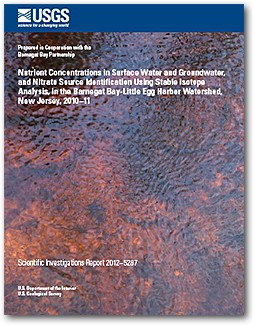 Abstract
Abstract
Five streams in the Barnegat Bay-Little Egg Harbor (BB-LEH) watershed in southern New Jersey were sampled for nutrient concentrations and stable isotope composition under base-flow and stormflow conditions, and during the growing and nongrowing seasons, to help quantify and identify sources of nutrient loading. Samples were analyzed for concentrations of total nitrogen, ammonia, nitrate plus nitrite, organic nitrogen, total phosphorus, and orthophosphate, and for nitrogen and oxygen stable isotope ratios.
Concentrations of total nitrogen in the five streams appear to be related to land use, such that streams in subbasins characterized by extensive urban development (and historical agricultural land use)—North Branch Metedeconk and Toms Rivers—exhibited the highest total nitrogen concentrations (0.84–1.36 milligrams per liter (mg/L) in base flow). Base-flow total nitrogen concentrations in these two streams were dominated by nitrate; nitrate concentrations decreased during storm events as a result of dilution by storm runoff. The two streams in subbasins with the least development—Cedar Creek and Westecunk Creek—exhibited the lowest total nitrogen concentrations (0.16–0.26 mg/L in base flow), with organic nitrogen as the dominant species in both base flow and stormflow. A large proportion of these subbasins lies within forested parts of the Pinelands Area, indicating the likelihood of natural inputs of organic nitrogen to the streams that increase during periods of storm runoff. Base-flow total nitrogen concentrations in Mill Creek, in a moderately developed basin, were 0.43 to 0.62 mg/L and were dominated by ammonia, likely associated with leachate from a landfill located upstream. Total phosphorus and orthophosphate were not found at detectable concentrations in most of the surface-water samples, with the exception of samples collected from the North Branch Metedeconk River, where concentrations ranged from 0.02 to 0.09 mg/L for total phosphorus and 0.008 to 0.011 mg/L for orthophosphate.
Measurements of nitrogen and oxygen stable isotope ratios of nitrate in surface-water samples revealed that a mixture of multiple subsurface sources, which may include some combination of animal and septic waste, soil nitrogen, and commercial fertilizers, likely contribute to the base-flow nitrogen load. The results also indicate that atmospheric deposition is not a predominant source of nitrogen transported to the BB-LEH estuary from the watershed, although the contribution of nitrate from the atmosphere increases during stormflow. Atmospheric deposition of nitrate has a greater influence in the less developed subbasins within the BB-LEH watershed, likely because few other major sources of nitrogen (animal and septic waste, fertilizers) are present in the less developed subbasins. Atmospheric sources appear to contribute proportionally less of the overall nitrate as development increases within the BB-LEH watershed.
Groundwater samples collected from five wells located within the BB-LEH watershed and screened in the unconfined Kirkwood-Cohansey aquifer system were analyzed for nutrient and stable isotope composition. Concentrations of nitrate ranged from not detected to 3.63 mg/L, with the higher concentrations occurring in the highly developed northern portion of the watershed, indicating the likelihood of anthropogenic sources of nitrogen. Isotope data for the two wells with the highest nitrate concentrations are more consistent with fertilizer sources than with animal or septic waste. Total phosphorus was not detected in any of the wells sampled, and orthophosphate was either not detected or measured at very low concentrations (0.005–0.009 mg/L) in each of the wells sampled.